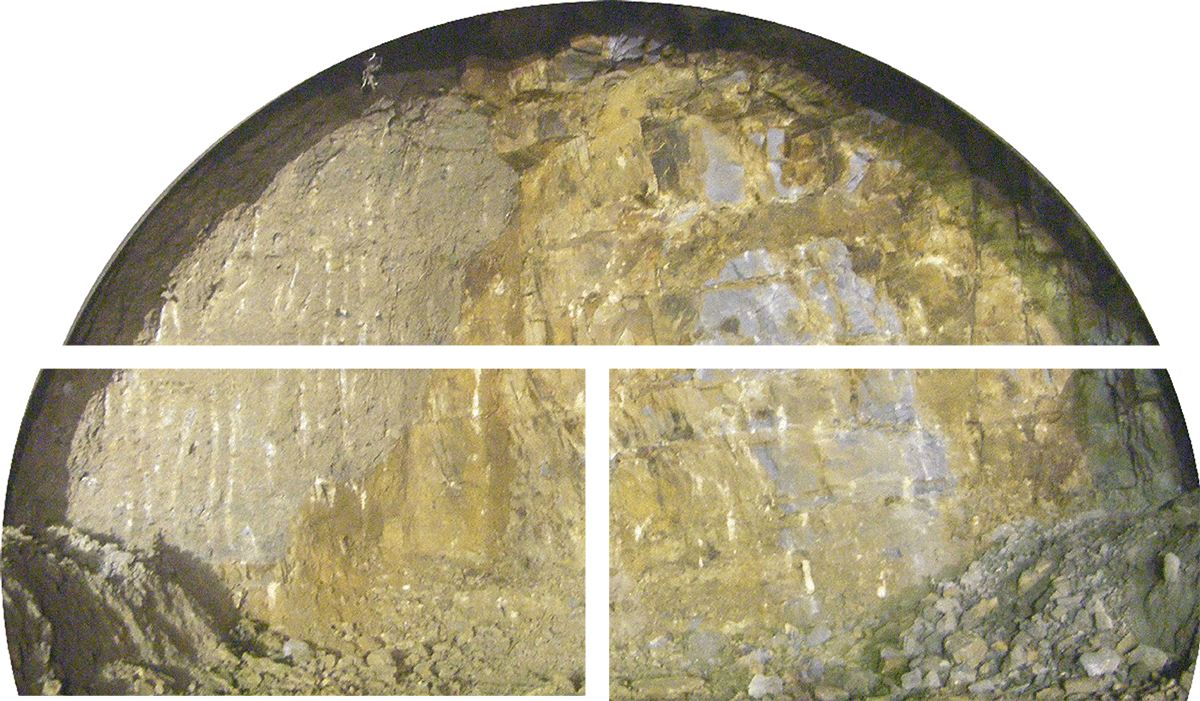- 4 Technology
- Technology Development
Using Deep Learning to Evaluate Mountain Tunnel Faces
Application of deep learning to the evaluation of the tunnel faces (excavation surfaces) in mountain tunnel construction
Aiming to enhance construction safety and economic performance by developing a high-precision tunnel face evaluation system utilizing AI technology
Obayashi Corporation has applied deep learning, an AI technology, to the evaluation of mountain tunnel faces.
In mountain tunnel construction in Japan, the NATM (New Austrian Tunneling Method) is the standard construction method. With this construction method, we use shotcrete and rock bolts as the major support members to appropriately secure the space after excavation by effectively utilizing the deformation resistance capacity of the rock mass itself. The support size is planned in advance based on a geological survey, but there are limits with the results of the advance survey only, so we actually conduct evaluations of the tunnel face based on the following seven items: compressive strength, weathering and alteration, crack intervals, crack conditions, strike and dip, water inflow, and water-induced deterioration. We then revise the plan as appropriate based on the evaluation results.
Since the first half of the 1990s, Obayashi Corporation has utilized revolutionary types of information technology such as image processing and expert systems in the mountain tunnel field to advance labor-saving in tunnel face behavior measurement work and the upgrading of analytical work. However, at actual construction sites, there are cases where conducting a comprehensive evaluation is difficult for anyone other than experts on rock mechanics or geological science, even if these technologies are utilized. The following has therefore been an issue; evaluations took a lot of time and effort due to, for example, the separate need for judgments by experts inside the company.
Therefore, Obayashi Corporation is advancing the development of a tunnel face evaluation system which utilizes deep learning to enable evaluations at the same level as those of experts on rock mechanics or geological science. This system makes it possible to evaluate geological conditions quickly and with high precision through the learning of tunnel face images and the evaluation results of experts. This enhances construction safety and economic performance by installing support members in a more appropriate way.
Note that this system is being developed through cooperation with MathWorks Japan.
The features of the system being developed are as follows.
-
Enhancement of construction safety and economic performance by instantly evaluating the tunnel face in fine detail
Formerly, the tunnel face images were divided into three parts to obtain an average evaluation: the crown, left shoulder, and right shoulder. However, with this system, the parts of the images are subdivided into sets of 227 × 227 pixels, and it is possible to evaluate the tunnel face for each individual part. The captured image is evaluated by subdividing it into approximately 70 parts in the case of 5,000,000 pixels or approximately 130 parts in the case of 10,000,000 pixels. This makes it possible to carry out local procedures in order to handle deformations and cave-ins of the tunnel face.
When humans conduct evaluations by subdividing the tunnel face, it takes a lot of time to produce results. However, with this system, we can use deep learning to instantly conduct a detailed evaluation, so construction safety and economic performance are enhanced.

The conventional tunnel face evaluation parts (three parts: the crown, left shoulder, and right shoulder) 
Tunnel face evaluation parts using AlexNet (the number of parts differs depending on the number of pixels at the time the photograph is taken) -
Evaluation precision is enhanced by learning the evaluation results of experts on rock mechanics and geological science
We are using AlexNet, a highly reliable image discrimination model, for the deep learning model.
The ratio of judgments that aligned with the evaluation results determined by experts was over 70% for all seven items.
In 2019, we transferred the system onto the cloud, so it can now be used at any site nationwide.
“Machine learning” technology in which a system learns the characteristics of data, then recognizes and classifies events. This system is called a neural network. It learns characteristics and similarities from large amounts of data. The system then classifies and determines new data by applying a mathematical model that emulates the complex human brain.
Technology which incorporates the knowledge and experience possessed by professional engineers into computers to solve complex specialized problems using those computers. With such systems, it is necessary for human beings to formulate this knowledge and experience.
A multi-layered neural network developed at the University of Toronto for the purpose of discriminating images. It demonstrated a low discrimination-error rate during the 2012 LSVRC (International Large Scale Visual Recognition Challenge) competition, which led to subsequent deep learning attracting a lot of attention.
- Management and
Organization- The Articles of Incorporation
- Basic Principles
- Transitioning of Corporate Symbol
- Corporate Officers
- Organization Chart
- Stock Information
- Financial Statements
- Technology
- BIM Timeline
- Awards
- Major Publication
- Group Companies
- Group Companies (in Japan)
- Group Companies (Overseas)